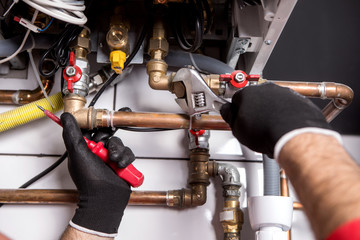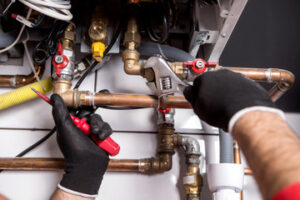Aurora CO Plumbers install, repair, and maintain pipes and fixtures for water distribution and waste water disposal in residential, commercial, and industrial settings. They follow blueprints and building codes to ensure plumbing systems are installed properly and meet regulatory standards.
Soft skills are also important for this profession, as plumbers often interact with clients to understand their issues and provide advice or solutions. This can involve negotiating with customers or explaining complex technical issues simply.

Plumbers install various plumbing fixtures and appliances in residential and commercial settings. This can include toilets, showers, baths, faucets, waste disposal units, and water heaters. Plumbers must adhere to local plumbing codes and regulations when installing these items. They also must be able to read blueprints and understand electrical wiring. They may also be responsible for laying pipes and other underground work.
Another common service offered by plumbers is the repair and maintenance of existing plumbing fixtures and pipes. This includes fixing leaks, clogged drains and sewer lines, and replacing worn parts. Plumbers also inspect pipes to diagnose problems, such as low water pressure and rusty water. They use hand tools and power tools to remove blockages, cut and fit pipe pieces, and make repairs. Plumbers must also be familiar with different types of pipe materials, such as PEX, PVC, ABS and copper. Older homes may have galvanized pipes, which can rust and lead to leaks. Plumbers will replace these with more durable pipes when necessary.
Those who are interested in becoming a plumber should pursue an apprenticeship and receive a tradesman’s certificate or equivalent. They must then pass a state-approved exam to become licensed. After completing their licensing exam, plumbers can begin working independently.
Service and repair plumbers are called in to troubleshoot and fix plumbing issues in residential and commercial settings. They must have excellent customer service skills to explain the problem and its solutions to customers in a clear and understandable manner. They also need to have strong problem-solving abilities to identify and fix issues in plumbing systems that are complex or large in scale.
Those who work as master plumbers oversee the installation of new plumbing systems in construction projects. They must be able to read blueprints and plans to determine the location of pipes and other underground work. They may also be responsible for setting up and repairing septic systems and drainage fields. Master plumbers often work on larger building projects and must adhere to strict time schedules and budgets. They must also be able to communicate with other contractors and clients effectively to ensure the project is completed on time and within budget.
Plumbing systems are complex, and the work they do is crucial to ensuring a safe and clean environment for people in homes, commercial spaces, and industrial facilities. Plumbers maintain these systems by performing routine checks and inspections, addressing any problems they identify, and making repairs as needed. They may also specialize in specific types of plumbing systems, such as gas or fire sprinklers.
Plumbers typically need a high school diploma or equivalent and complete an apprenticeship program to gain the skills and experience necessary for their career. Many community colleges and vocational schools offer affordable plumbing programs that allow students to earn money while learning the trade.
Once qualified, master plumbers can handle a wide range of installation and repair tasks. They may install new plumbing systems in residential and commercial properties, inspect existing ones, and perform tests to ensure that water and gas are flowing properly through pipes and fixtures. They also interpret building codes and regulations to ensure compliance and obtain necessary permits.
Service and repair plumbers address problems that are not immediately dangerous, such as clogged drains or malfunctioning water heaters. They listen to customer concerns, analyze the problem, and determine the best way to fix it. They must be able to diagnose the problem quickly and understand how it impacts other areas of the system.
While some plumbers specialize in residential or commercial settings, others work on large-scale plumbing projects for government buildings and institutions such as hospitals, universities, and factories. These projects require them to collaborate with engineers and architects to design plumbing systems that meet the needs of a particular facility.
A career as a plumber can be challenging because of the physical demands of the job, but it also offers many benefits. People who enjoy working with their hands and like interacting with customers often find it rewarding. In addition, plumbers can make good money and avoid long commutes by working locally. To maximize the benefits of a career as a plumber, workers should prioritize safety and invest in professional development to stay up-to-date on industry standards.
Plumbers repair and maintain plumbing systems in residential, commercial, and industrial settings. They install water heaters, repair toilets and faucets, unclog drains, and inspect and repair sewer lines. They also have the skills to repair a wide variety of other home and commercial appliances. Plumbers can work independently or for a plumbing company.
A plumber’s job requires physical stamina and the ability to lift heavy objects. It’s also important for plumbers to be detail-oriented and able to follow instructions. Plumbing is a complex trade that involves working with a wide range of tools and materials. It’s common for plumbers to encounter hazardous chemicals, so they need to be careful when handling them.
The most common repairs plumbers perform are for leaky pipes and fixtures. Leaking pipes can cause serious water damage to a home, so plumbers need to detect them as quickly as possible and implement repair strategies. These may include repairing or replacing the damaged part, installing a new one, or using an alternative method to stop the leak.
Many homeowners need help with their sewage system. This can lead to unpleasant odors, damp basements, and other issues. Plumbers need to understand how to repair these systems and how to prevent future issues.
Another common plumbing problem is clogged drains. These can be caused by food scraps, hair, paper products, and other items that shouldn’t be flushed down the drain. Plumbers can use specialized equipment to remove clogs and restore the flow of water in the pipe.
Older homes may have galvanized pipes, which are more likely to rust and break than modern pipes. Plumbers can replace these older pipes with PEX or PVC piping, which are durable and rust-resistant. They can also install new faucets and fixtures, including garbage disposals. Plumbers can also help with other household maintenance tasks, such as maintaining lawn sprinklers or washing machines. Plumbing maintenance services are usually provided at an hourly rate, but the rates can vary depending on the plumber’s experience and expertise level. Those who are more experienced tend to charge higher rates than those who are less familiar with plumbing.
Plumbing troubleshooting is a logical and systematic search for the source of problems. It involves identifying and eliminating potential causes of the problem until you find the one that explains all the symptoms. Once you identify the cause, you can fix the problem and restore the system to proper working condition.
In plumbing, troubleshooting is especially important because most of the time, problems are not visible and cannot be easily diagnosed. This is because pipes are hidden behind walls and inside ceilings, and many of the components of a plumbing system are interconnected. This means that when one part of a plumbing system stops functioning, it could impact the entire system. Plumbers use a variety of tools and techniques to troubleshoot plumbing problems.
For example, if you have low water pressure in your home, there could be a problem with the main line or a valve. A plumber will check all the connections to the water pump and main line to determine the source of the issue. If it’s a faulty valve, the plumber will open up the wall and replace the valve. If the issue is with a main line, the plumber will use a snake to remove any blockage and then clean the pipe with high-pressure water.
Another service that plumbers offer is sewer cleaning. This is a process where they use an infrared camera to locate any blockages in the drain lines and then clear them with a snake or by shooting pressurized water into the line. This is a more effective and less invasive method of clearing drains than using chemical solutions.
Other common troubleshooting services include fixing leaking faucets and toilets, installing water filters and repairing water heaters. It’s important for homeowners to regularly schedule these services to prevent more serious problems in the future.
Commercial plumbers are also trained to troubleshoot and repair larger-scale plumbing systems in offices, hospitals, restaurants, factories, and other businesses. These larger-scale plumbing systems are more complicated than residential ones, requiring specialized knowledge and equipment to maintain. Troubleshooting these types of systems requires more time on the job because the plumbers need to inspect the entire system to identify any issues.

 Determining smaller leaks and running toilets is easier in a residence since homeowners use their home plumbing regularly and will notice small issues that could lead to costly dripping and wasted water.
Determining smaller leaks and running toilets is easier in a residence since homeowners use their home plumbing regularly and will notice small issues that could lead to costly dripping and wasted water.